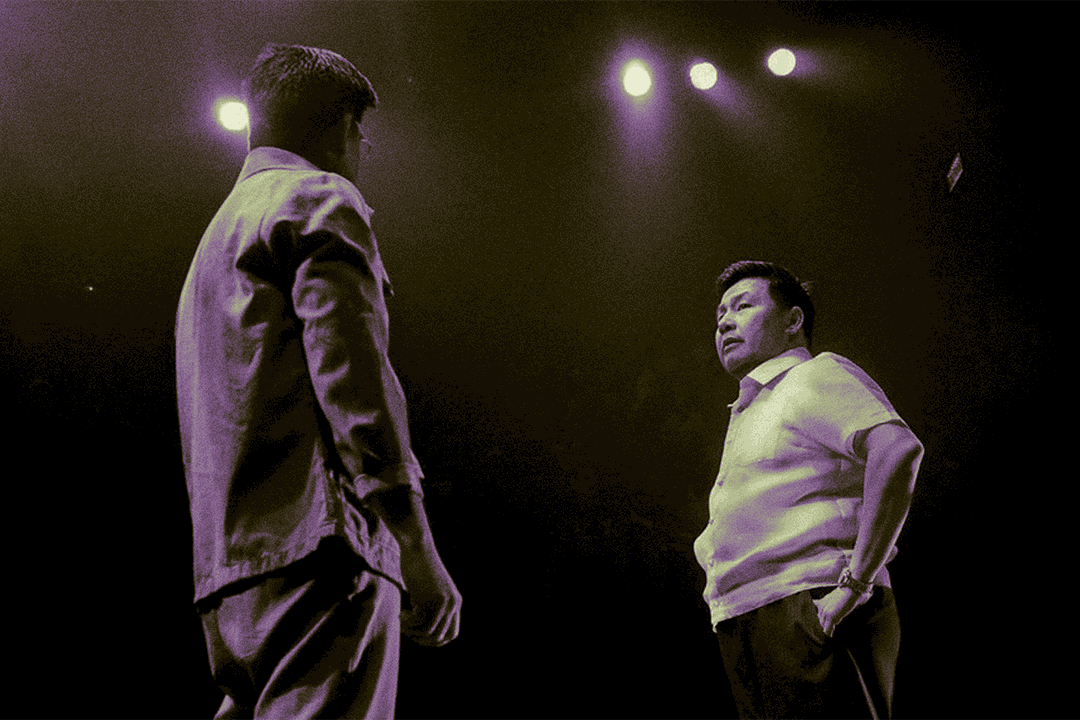'Kumprontasyon': An abridged journal entry pseudo-essay
‘Kumprontasyon’: An abridged journal entry pseudo-essay
Kumprontasyon started with Lakambini, set in the development stages of the Philippine republic, starring Gregoria de Jesus (A Very Good Girl star Sherry Lara) and Emilio Aguinaldo (Historya ni Ha star Terry Guzman). Out of the three plays, this is the most explicit when it comes to the confrontation aspect, where Gregoria and Emilio argued inside a room throughout the entire duration (this isn’t unique to Lakambini but the tension was the highest in this segment). Gregoria was incredibly confrontational, which was expected as the First Lady of the revolution. The conflict revolves around why Andres was killed for the revolution to end and how Emilio was on the boot for American help after the revolution, resulting in the Philippines being under American influence during and after his presidency. The brutal imagery that formed in me when Gregoria was explaining how Andres, her husband, painfully suffered his last remaining days before eventually succumbing to his injuries. I personally didn’t know the information said in this segment (especially after reading that this play is based on real-life events), but it intrigued me to know if Emilio kneeled down and begged for forgiveness for what he had done not only to his closest ally, but to the Filipinos, who even now are still influenced by American culture and values. Like Gregoria, I’ve also wondered what would be different if Andres led the Philippine Republic; iif it would still be the same as the Philippines today.
It’s a play where you think about the past, and how the political climate of the Philippines has always been tumultuous from the start, with this play reimagining in the room where it happened—Gregoria and Emilio in a room, 1 year after the revolution and Philippine independence. What I’ve also noticed is how Gregoria and Emilio are never on the same side of the stage, and how one moves when the other is approaching. I liked this blocking, in a sense that you can see how both characters are uncomfortable near each other, and emphasized that Gregoria and Emilio are not on the same side after Andres died. My favorite scene is when Gregoria angrily explains her husband’s condition and how she begged Emilio’s house for some help, yet no one came through. Her voice is cracking, almost to tears but her conviction is felt through–her anger, her despair, all for the audience to see and hear. It’s excruciating knowing that all you can do is beg for help from those you considered allies before, now turning a blind eye to what is happening to your family. How the Philippine revolution broke your family apart, leaving you widowed and leaving your kids fatherless. She never even saw her husband’s dead body, as if it was retrieved and sent away; Gregoria was not even allowed to grieve for her husband properly, for which Emilio’s governance is to blame. It was an emotionally driven play, where both Lara and Guzman excelled in showcasing each of their acting prowess as de Jesus and Aguinaldo, respectively. I’m just glad we have an 8-minute break so I can digest what just happened because it was a great start for my theater play experience this 2024.
The next play is titled The Impossible Dream, starring an unnamed President (Bamboo Dogs star Ron Capinding) and Senator (About Us But Not About Us star Romnick Sarmenta). We know when this was supposed to have happened and who these characters represent. This segment revolves around the Senator being accused of inciting a communist coup and the President requesting for a confession. Their introduction was peculiar, in a way that both characters seemed to be rowing while sitting on a chair (I still can’t describe it until now, which says something). The President’s abuse of power kicked off after they’ve rowed enough, probably a metaphor for how you can row to Malacañang Palace as an alternative commute because of how traffic plagued the entirety of NCR. Going back to my previous point–abuse of power–the President didn’t waste any time to prove that he is the most powerful person in the country by borrowing a relic from the National Museum just to gaze at the jar in his own space. I think the metaphor in their intro is aligned with how the President explained the jar containing the ashes of two people, with its cap in the shape of a boat for two people. Filipinos are intellectual beings indeed, even before the Spanish occupation, they already had a belief in an afterlife. The play goes on a cat-and-mouse chase between the President, who insists that he will pardon the senator if he just confesses, and the Senator, who will never confess anything because he did no such thing. I can insinuate that both characters might have been in the same fraternity back in college (hence, the call for brod/brother) or at least were long-time friends.
And I think it’s this factor that made their confrontation a bit painful, since both of them had spent time together because of this uncomfortable situation. If Lakambini is about confrontation between former allies, The Impossible Dream is about confrontation between former friends, or so one would think. As the play went on, pieces of what the Senator “did” were unraveled; I got the idea that it was about a communist insurgency at the start, because that was what the real-life version of the President did during his regime—accusing and killing communists behind-the-scenes. One scene that stood out for me is during the taumbayan montage; the Senator proclaiming that they are nothing in the grand scheme of history, in both the universe and in the Philippines—that a confession is the least of their worries and time will still flow whether a confession was made or not. While this was a play that is “loosely based on real events—at least on the characters,” what the President said is what happened in real life; the Senator is a footnote of Philippine history, but his determination is admirable nonetheless. Despite countless persuasions, from seeing sunlight to a chance to talk with his wife, the Senator remained true to his stance—an admirable thing to be despite every single thing being against you. In the end, their match remained in a stalemate, with both characters rowing again in the sea of history, unbeknownst to them what the history will write for the both of them. This was my favorite out of the three, partly because of its symbolism and execution, but mostly due to Ron Capinding’s performance as the President. He was hilarious, convincing, and imposing during times were it’s necessary. I was in awe of his performance, especially during my favorite scene where he didn’t speak when the taumbayan were moving his body. The way he delivered his lines is the most memorable of the entire performance and it helped that Romnick Sarmenta’s equally powerful delivery as the Senator really made the pseudo two-man show a great starter for my 2024 in the theater space.
The last segment of Kumprontasyon is A Color for Tomorrow which is set in the future, probably in the 2060s, It started with the Woman doing a futuristic version of yoga and introducing us to “Emu,” a prototype who can browse your memories and bring a copy of yourself in a specific age to life, amongst its other capabilities. The concept itself is interesting for a theater act, especially without the help of visual effects that accompanies films and TV series. Like the Woman, we’re interested in testing the technology, and what more to start than to bring our childhood selves out, which the woman did by conjuring her 10-year-old self out. She was shocked and even disgusted by her childlike state—a time when she was frivolous, naive, and innocent. Like her, we think of our childhood through nostalgic lenses and not realize that even though those times were our happiest, it was also our dumbest, most idiotic state where we only cared about superficial things like happy crushes, toys, and what the food we’ll eat for dinner. After sending her 10-year-old self away, she summed up her 24-year-old self, the age where she was a volunteer advertiser for the 2022 Presidential campaign of Leni and Kiko. Emu 24 retold a story where she was touched by a simple gesture of kindness done by another Leni-Kiko supporter during one of the rallies. Being older, wiser, and somewhat crueler, the Woman kept on minimizing the kindness that was shown to her 24-year-old self; the person could’ve been horrible behind closed doors, but isn’t that the beauty of it? A simple action like handing bottled water to those who seemed thirsty starts and ends after that event; no need for an exchange of names or other information, and yet, that simple action can be memorable. The Woman then summoned what she thought was her prime, her 37-year-old self. They then talked about how after being beaten down election after election, she decided to shift to the other side, where she started her new career as a propagandist, using hate as her main tool of influence. It can be observed from the previous Philippine elections that hate was effective for the other camp to win—making personal comments about Leni and her family (hence, why Leni lugaw is still showing in her comments even 2 years after the election). This was the scene where I honestly resonated with the 37-year-old woman; I also desire to be in the winning camp and it’s frustrating to know how your presidential bet has a higher chance of winning if she just plays the game as dirty as the others did, but Leni and her camp are prideful and steadfast in their beliefs, which is admirable yet also her downfall. The Woman’s 37-year-old self then reminded the Woman of what they did during that time which turned her mood from admiration to disgust.
Like our childhood, we think of our prime year in rose-colored glasses, not realizing that we also did unspeakable things that we buried in our minds. I personally didn’t get what she did during that time, but I can only infer that she pushed someone to either commit suicide or have someone killed. Whatever that may be is not the point, which is why she had that part of herself removed from the platform. She then called her 49-year-old self, dubbed the year of her gradual downfall. Knowing her camp’s history of killings and beatings behind the scenes, I was also shocked that she was not killed, knowing how she was fundamental in electing certain political figures. I think that this was her last year of freedom, hence that was why she called that part of herself—to have a reminder of what happened before everything fell apart. She comforted and even let her past self sleep, knowing that everything would be difficult when she wakes up. The Woman once again called her 24-year-old self, reminding her of the song she wasn’t able to complete. Together, they managed to complete the song, which reminded me of the simple gesture story from earlier; helping someone’s song is an action one can do without any information from the other, yet it can be someone’s core memory. It ended with all characters doing the futuristic yoga step, which gives a nod to the previous play, The Impossible Dream, where it also redid its intro in its ending. My favorite of the performers is certainly the Woman (A Very Good Girl star Missy Maramara), whose emotions are all over the place, nicely. Emu 24 (Mercury is Mine actor Uzziel Delamide) and Emu 37 (Gaya sa Pelikula star Adrienne Vergara) were my favorite years of the protagonist, highlighting the yin and yang of past self. I love the contrast in beliefs and aspirations, with each taking a jab at one another; IMU 24 not believing that her future self will be at the enemy side and Imu 37 laughing at her past self’s naïveté. Out of the three plays in Kumprontasyon, this was the play specifically targeted with confronting oneself, which I think was the most difficult in execution, but the three leads managed to connect each other as one entity, and also create a distinction between different ages.
While it is obvious that all plays on Kumprontasyon are about confrontation (hence the title), I’m amazed how it tackles three different versions and how each play was executed, with Lakambini’s confrontation between ex-allies now-enemies, The Impossible Dream’s confrontation between ex-friends now-acquaintances, and A Color for Tomorrow’s confrontation between past-selves now-memories. I hope to witness more of this concept in future theater plays in the Philippines.





















